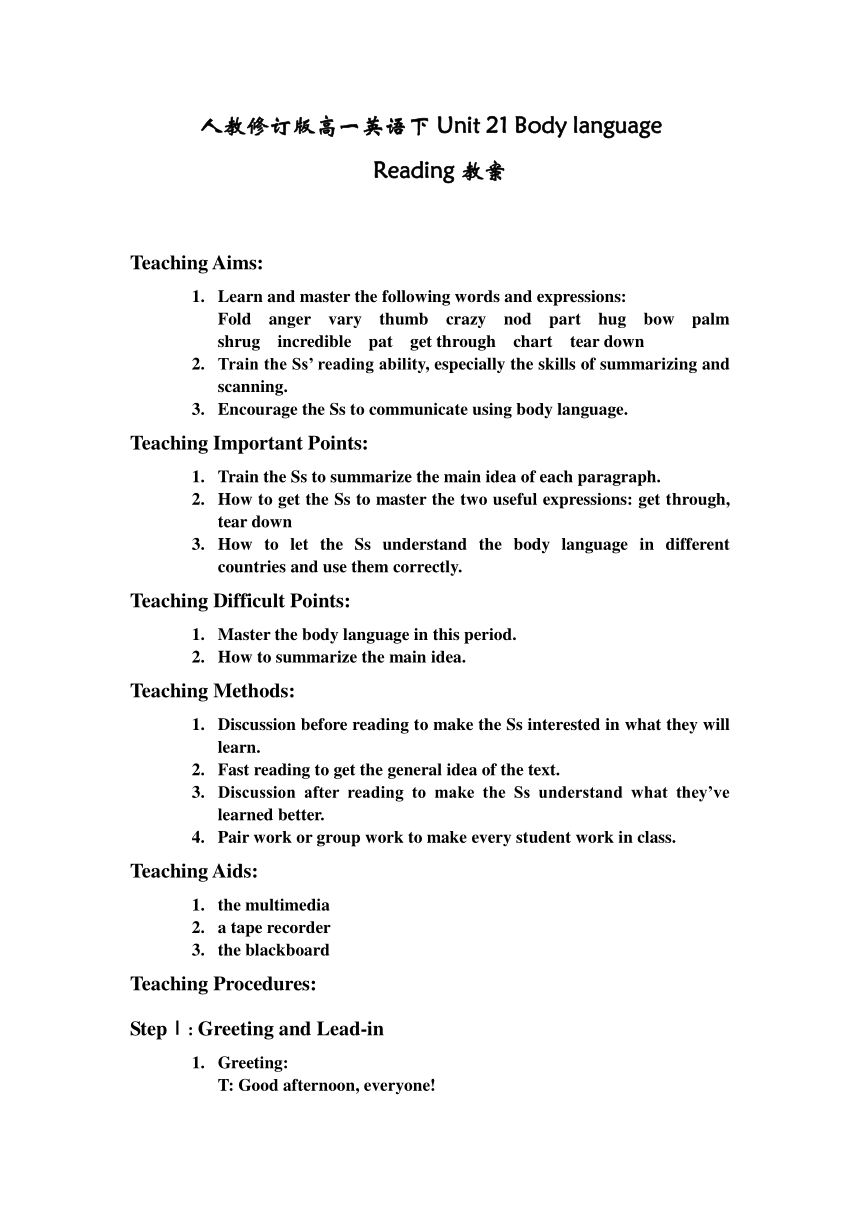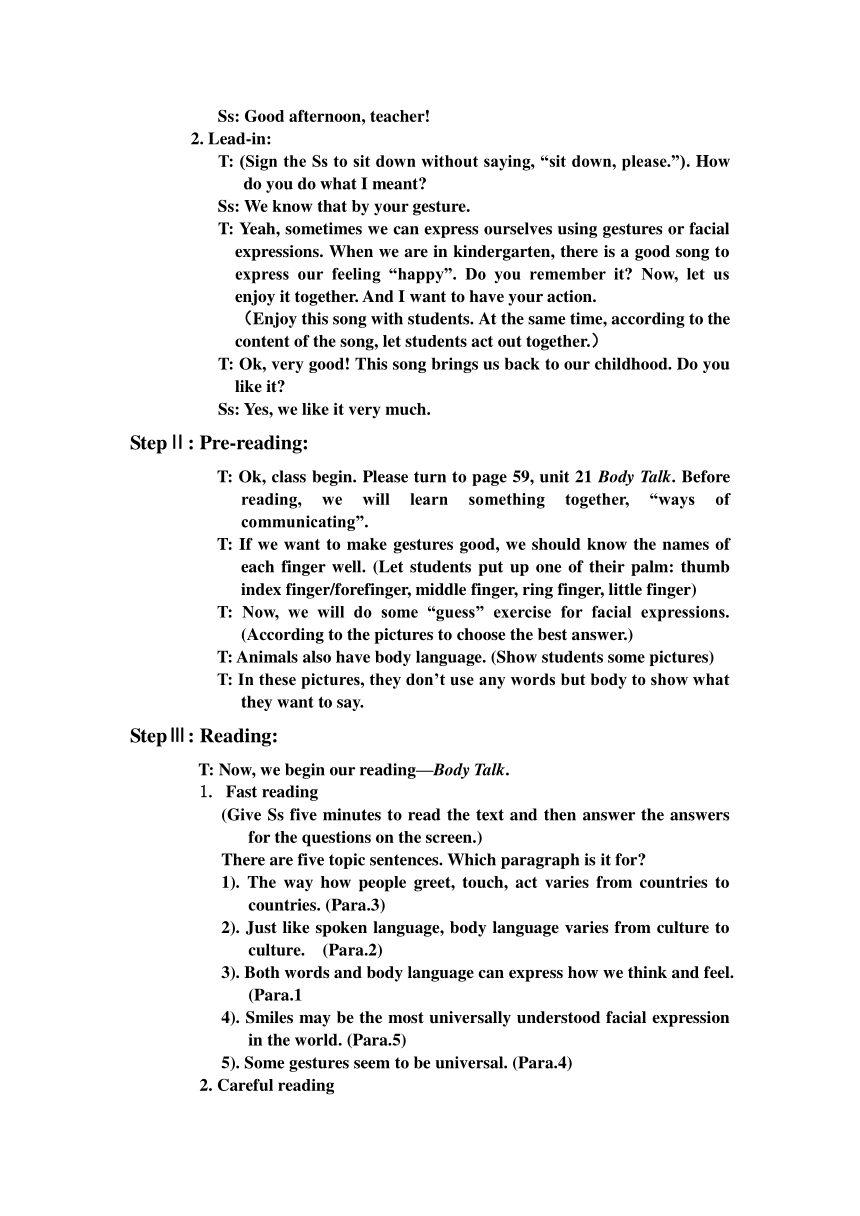高一下Unit 21 Body language Reading教案[下学期]
文档属性
| 名称 | 高一下Unit 21 Body language Reading教案[下学期] |  | |
| 格式 | rar | ||
| 文件大小 | 13.2KB | ||
| 资源类型 | 教案 | ||
| 版本资源 | |||
| 科目 | 英语 | ||
| 更新时间 | 2006-08-13 13:58:00 | ||
图片预览


文档简介
人教修订版高一英语下Unit 21 Body language
Reading教案
Teaching Aims:
1. Learn and master the following words and expressions:
Fold anger vary thumb crazy nod part hug bow palm shrug incredible pat get through chart tear down
2. Train the Ss’ reading ability, especially the skills of summarizing and scanning.
3. Encourage the Ss to communicate using body language.
Teaching Important Points:
1. Train the Ss to summarize the main idea of each paragraph.
2. How to get the Ss to master the two useful expressions: get through, tear down
3. How to let the Ss understand the body language in different countries and use them correctly.
Teaching Difficult Points:
1. Master the body language in this period.
2. How to summarize the main idea.
Teaching Methods:
1. Discussion before reading to make the Ss interested in what they will learn.
2. Fast reading to get the general idea of the text.
3. Discussion after reading to make the Ss understand what they’ve learned better.
4. Pair work or group work to make every student work in class.
Teaching Aids:
1. the multimedia
2. a tape recorder
3. the blackboard
Teaching Procedures:
StepⅠ: Greeting and Lead-in
1. Greeting:
T: Good afternoon, everyone!
Ss: Good afternoon, teacher!
2. Lead-in:
T: (Sign the Ss to sit down without saying, “sit down, please.”). How do you do what I meant
Ss: We know that by your gesture.
T: Yeah, sometimes we can express ourselves using gestures or facial expressions. When we are in kindergarten, there is a good song to express our feeling “happy”. Do you remember it Now, let us enjoy it together. And I want to have your action.
(Enjoy this song with students. At the same time, according to the content of the song, let students act out together.)
T: Ok, very good! This song brings us back to our childhood. Do you like it
Ss: Yes, we like it very much.
StepⅡ: Pre-reading:
T: Ok, class begin. Please turn to page 59, unit 21 Body Talk. Before reading, we will learn something together, “ways of communicating”.
T: If we want to make gestures good, we should know the names of each finger well. (Let students put up one of their palm: thumb index finger/forefinger, middle finger, ring finger, little finger)
T: Now, we will do some “guess” exercise for facial expressions. (According to the pictures to choose the best answer.)
T: Animals also have body language. (Show students some pictures)
T: In these pictures, they don’t use any words but body to show what they want to say.
StepⅢ: Reading:
T: Now, we begin our reading—Body Talk.
1. Fast reading
(Give Ss five minutes to read the text and then answer the answers for the questions on the screen.)
There are five topic sentences. Which paragraph is it for
1). The way how people greet, touch, act varies from countries to countries. (Para.3)
2). Just like spoken language, body language varies from culture to culture. (Para.2)
3). Both words and body language can express how we think and feel. (Para.1
4). Smiles may be the most universally understood facial expression in the world. (Para.5)
5). Some gestures seem to be universal. (Para.4)
2. Careful reading
1). Let Ss read the first paragraph and answer the question:
Besides words, how can we know what a person is thinking or feeling
by watching his or her body language.
2). Let Ss read paragraph two and three, and then fill the forms in the following.
country meaning
eye contact Some countries
Other countries
gesture country meaning
making a circle with one’s thumb and index finger Most countries OK
money
France
rude
gesture country meaning
thumbs up The US
rude
Germany
Japan
country meaning
moving the index fingerin a circle in front of the ear Some countries
Other countries
meaning gesture countries
Yes Shaking one’s head
No Shaking one’s head other countries
Greet friends Kiss on the cheek
A firm handshake
A loving hug other countries
A bow/ a nod of head
3). Let Ss read paragraph four and five and then fill the forms in the following.
meaning gesture
I’m tired
I’m full
I’m hungry
StepⅣ: Post-reading:
1. T: Fill in the blanks for retell the text.
We use both words and _____language to communicate with people, but just like ______language, it varies from culture to ______. In Japan, the gesture for OK means______ , but in France it means____, and in Brazil and ________ it is rude. While there are many ________ interpretations of body language, some gestures seem to be ________. Perhaps the best _______ of widely used body language is the _____.
2. Game.
StepⅣ: Summary:
T: After reading this passage, we know in different countries, there are different body talk, so we should follow this advice, “When in Rome, do as the Romans do!” Time is up, class over.
StepⅣ: Homework:
1. Read the passage and recite it.
2. Do exercise 1-4 in post-reading on page 60
StepⅤ: The Design of the Blackboard
Fold
vary
thumb
crazy
nod
part
hug
bow
palm
shrug
incredible
pat
get through
chart
tear down
Reading教案
Teaching Aims:
1. Learn and master the following words and expressions:
Fold anger vary thumb crazy nod part hug bow palm shrug incredible pat get through chart tear down
2. Train the Ss’ reading ability, especially the skills of summarizing and scanning.
3. Encourage the Ss to communicate using body language.
Teaching Important Points:
1. Train the Ss to summarize the main idea of each paragraph.
2. How to get the Ss to master the two useful expressions: get through, tear down
3. How to let the Ss understand the body language in different countries and use them correctly.
Teaching Difficult Points:
1. Master the body language in this period.
2. How to summarize the main idea.
Teaching Methods:
1. Discussion before reading to make the Ss interested in what they will learn.
2. Fast reading to get the general idea of the text.
3. Discussion after reading to make the Ss understand what they’ve learned better.
4. Pair work or group work to make every student work in class.
Teaching Aids:
1. the multimedia
2. a tape recorder
3. the blackboard
Teaching Procedures:
StepⅠ: Greeting and Lead-in
1. Greeting:
T: Good afternoon, everyone!
Ss: Good afternoon, teacher!
2. Lead-in:
T: (Sign the Ss to sit down without saying, “sit down, please.”). How do you do what I meant
Ss: We know that by your gesture.
T: Yeah, sometimes we can express ourselves using gestures or facial expressions. When we are in kindergarten, there is a good song to express our feeling “happy”. Do you remember it Now, let us enjoy it together. And I want to have your action.
(Enjoy this song with students. At the same time, according to the content of the song, let students act out together.)
T: Ok, very good! This song brings us back to our childhood. Do you like it
Ss: Yes, we like it very much.
StepⅡ: Pre-reading:
T: Ok, class begin. Please turn to page 59, unit 21 Body Talk. Before reading, we will learn something together, “ways of communicating”.
T: If we want to make gestures good, we should know the names of each finger well. (Let students put up one of their palm: thumb index finger/forefinger, middle finger, ring finger, little finger)
T: Now, we will do some “guess” exercise for facial expressions. (According to the pictures to choose the best answer.)
T: Animals also have body language. (Show students some pictures)
T: In these pictures, they don’t use any words but body to show what they want to say.
StepⅢ: Reading:
T: Now, we begin our reading—Body Talk.
1. Fast reading
(Give Ss five minutes to read the text and then answer the answers for the questions on the screen.)
There are five topic sentences. Which paragraph is it for
1). The way how people greet, touch, act varies from countries to countries. (Para.3)
2). Just like spoken language, body language varies from culture to culture. (Para.2)
3). Both words and body language can express how we think and feel. (Para.1
4). Smiles may be the most universally understood facial expression in the world. (Para.5)
5). Some gestures seem to be universal. (Para.4)
2. Careful reading
1). Let Ss read the first paragraph and answer the question:
Besides words, how can we know what a person is thinking or feeling
by watching his or her body language.
2). Let Ss read paragraph two and three, and then fill the forms in the following.
country meaning
eye contact Some countries
Other countries
gesture country meaning
making a circle with one’s thumb and index finger Most countries OK
money
France
rude
gesture country meaning
thumbs up The US
rude
Germany
Japan
country meaning
moving the index fingerin a circle in front of the ear Some countries
Other countries
meaning gesture countries
Yes Shaking one’s head
No Shaking one’s head other countries
Greet friends Kiss on the cheek
A firm handshake
A loving hug other countries
A bow/ a nod of head
3). Let Ss read paragraph four and five and then fill the forms in the following.
meaning gesture
I’m tired
I’m full
I’m hungry
StepⅣ: Post-reading:
1. T: Fill in the blanks for retell the text.
We use both words and _____language to communicate with people, but just like ______language, it varies from culture to ______. In Japan, the gesture for OK means______ , but in France it means____, and in Brazil and ________ it is rude. While there are many ________ interpretations of body language, some gestures seem to be ________. Perhaps the best _______ of widely used body language is the _____.
2. Game.
StepⅣ: Summary:
T: After reading this passage, we know in different countries, there are different body talk, so we should follow this advice, “When in Rome, do as the Romans do!” Time is up, class over.
StepⅣ: Homework:
1. Read the passage and recite it.
2. Do exercise 1-4 in post-reading on page 60
StepⅤ: The Design of the Blackboard
Fold
vary
thumb
crazy
nod
part
hug
bow
palm
shrug
incredible
pat
get through
chart
tear down
